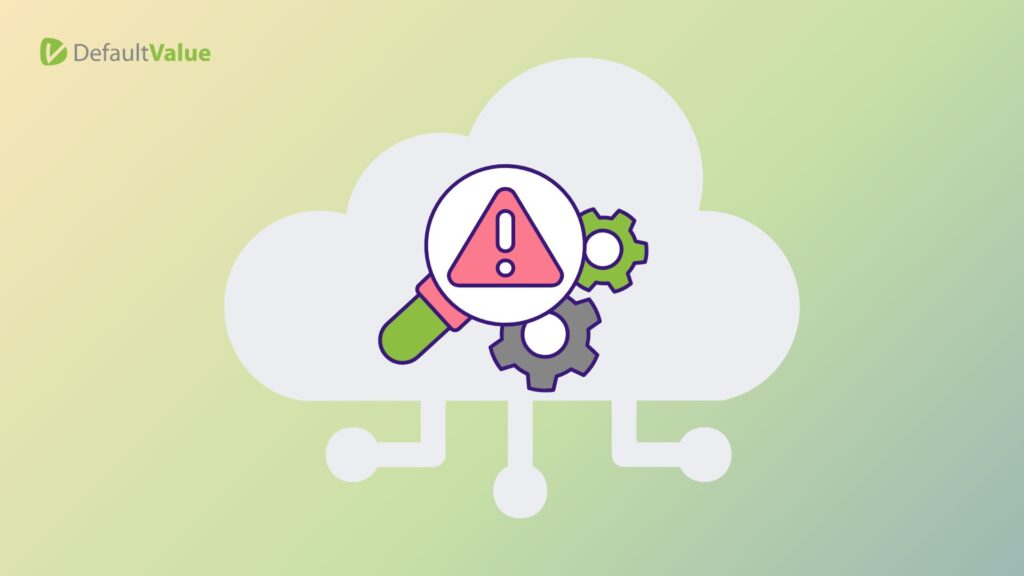Cloud Migration Risks Unveiled: Navigating the Challenges of Transitioning to the Cloud
In today’s digital landscape, cloud migration has emerged as a transformative force for businesses across various industries. Among those benefiting greatly from this paradigm shift are eCommerce businesses, leveraging the power of the cloud to propel their growth and success. Cloud migration offers immense potential, enabling eCommerce companies to scale their operations, enhance agility, improve customer experiences, and optimize cost efficiencies. However, with great opportunities come inherent cloud migration risks and challenges that must be navigated with expertise and precision.
At Default Value, we understand the critical role that cloud migration plays in the success of eCommerce businesses. As a leading provider of cloud migration services, we offer comprehensive solutions tailored to address the unique requirements of our clients. Our team of skilled specialists possesses a deep understanding of cloud infrastructure, security, and data management, allowing us to guide businesses through the intricacies of the migration process.
While cloud migration presents numerous advantages, it is not without risks. Data breaches, compatibility issues, and operational disruptions can arise if the migration is not executed with meticulous planning and execution. That’s where our expertise comes into play. In this article, we want to take a closer look at the risks of cloud migration and how to avoid them.
What is cloud migration?

Cloud migration refers to the process of transferring an organization’s digital assets, applications, and data from traditional on-premises infrastructure to a cloud-based environment. It is a complex and strategic undertaking, with various risks and challenges. A successful cloud migration project necessitates careful planning and consideration of different cloud migration approaches. By migrating to the cloud, businesses can leverage the scalability, flexibility, and cost-efficiency offered by cloud computing. However, it’s important to recognize the potential risks in cloud migration, such as data breaches, vendor lock-in, and operational disruptions. Therefore, organizations must adopt comprehensive risk mitigation strategies and work closely with cloud service providers to ensure a smooth and secure transition to the cloud server migration.
According to CloudZero, organizations can achieve substantial profit growth, up to 11.2% year-over-year, by leveraging cloud migration to unlock new revenue streams. To maximize financial gains, it is recommended to have a minimum of 60% of workloads in the cloud.
Why should businesses migrate their solutions to the Cloud?

Businesses are increasingly opting to migrate their solutions to the cloud due to a multitude of compelling benefits. Firstly, cloud migration allows organizations to significantly reduce IT costs. By leveraging cloud resources, businesses can easily scale their computing capabilities according to their specific needs, eliminating unnecessary expenditures and optimizing their budget allocation. Moreover, migrating to the cloud enhances business agility by providing the ability to swiftly scale up or down in response to market demands, enabling organizations to stay nimble and maintain a competitive edge.
Enhanced security is another crucial advantage offered by cloud migration. Cloud providers offer robust security features such as data encryption, multi-factor authentication, and regular security updates, providing businesses with heightened protection against cyber threats. This allows organizations to focus on their core operations while entrusting the security responsibilities to dedicated professionals.
Cloud migration also eliminates concerns related to end-of-life issues. The need to replace aging hardware or software can be costly and time-consuming. By migrating to the cloud, businesses can offload the burden of infrastructure management to the cloud provider, ensuring seamless updates and maintenance without disruptions.
Consolidating data centers is an additional benefit of cloud migration. Through this process, businesses can reduce their physical footprint and achieve significant cost savings while improving operational efficiency. The cloud’s scalability and flexibility enable organizations to streamline their infrastructure and optimize resource utilization.
Furthermore, cloud migration empowers businesses to embark on digital transformation journeys. With access to advanced analytics, machine learning, and emerging technologies, organizations can unlock new avenues for growth and innovation. The cloud becomes a catalyst for accelerating business expansion and facilitating efficient scalability.
What business problems can cloud solutions solve?
Cloud solutions offer effective solutions to a wide range of business problems, empowering organizations to overcome various challenges.
| Cost Savings | Cloud solutions eliminate the need for costly hardware and software investments, reducing IT infrastructure expenses and improving financial performance. |
| Mobility and Flexibility | Cloud solutions enable businesses to work from anywhere, anytime, and on any device, enhancing productivity and facilitating seamless collaboration. |
| Scalability | Cloud solutions provide the ability to scale up or down rapidly in response to changing demands, allowing businesses to stay competitive and seize new opportunities swiftly. |
| Data Sharing and Collaboration | Cloud solutions facilitate inter-organization data sharing, breaking down data silos and optimizing workflows for enhanced efficiency and stronger relationships with partners, suppliers, and customers. |
| Data Security and Recovery | Cloud solutions offer advanced security features like data encryption, multi-factor authentication, and regular updates, ensuring robust protection against cyber threats. Additionally, they provide reliable data backup and recovery capabilities for business continuity and minimizing the impact of disasters or data loss. |
| Operational Flexibility | Cloud solutions provide scalability, advanced analytics, machine learning tools, and seamless integration capabilities, enabling businesses to adapt to dynamic market conditions and customer needs, driving innovation and long-term success. |
| Environmental Sustainability | Cloud solutions contribute to environmental sustainability by reducing energy consumption and carbon footprint through the elimination of on-premises hardware and data centers. |
| IT Maintenance Efficiencies | Cloud solutions minimize IT maintenance efforts, allowing businesses to focus on core activities rather than managing hardware and software updates. |
| Resilience and Uptime | Cloud solutions improve resilience and uptime, reducing disruptions and ensuring continuous operation of business-critical systems and applications. |
| Scalability without Hardware Upgrades | Cloud solutions support scalability without the need for costly hardware upgrades, providing businesses with the flexibility to meet growing demands efficiently. |
What do you need to consider before migrating to the cloud?

Before embarking on a cloud migration journey, businesses must carefully consider several factors to ensure a smooth and successful transition. One crucial consideration is developing a comprehensive migration strategy. This involves identifying the applications and data that will be migrated, selecting the appropriate cloud deployment model (public, private, or hybrid), and choosing the right cloud service provider that aligns with the organization’s specific needs.
Security and governance are paramount considerations when migrating to the cloud. Businesses must evaluate the security measures offered by cloud providers, ensure data compliance with relevant regulations, and implement additional security measures if necessary. Proper project management and logistics are also vital to ensure a successful migration. Establishing a competent migration team, defining clear timelines and milestones, and effectively managing the migration process are essential elements for a smooth transition.
The deployment approach is another critical factor. Businesses must decide whether to opt for a lift-and-shift strategy, re-architect applications for the cloud, or adopt a hybrid cloud model that combines on-premises and cloud infrastructure. Assessing the compatibility of the infrastructure stack with the cloud environment is necessary to prevent any incompatibility issues.
Conducting a thorough analysis of workloads helps determine which ones are suitable for the cloud migration. Data protection is crucial throughout the migration process, necessitating the implementation of robust backup and recovery solutions. Ensuring adequate cloud service accessibility, including network connectivity and bandwidth requirements, is vital for uninterrupted business operations.
Total cost considerations encompass evaluating the expenses associated with cloud services, migration tools, and additional security measures. Selecting the right cloud provider based on reliability, scalability, and security features is paramount for a successful migration.
What can go wrong when migrating to the cloud?

Migrating to the cloud can present numerous challenges and potential pitfalls. Without proper preparation, businesses may encounter the following issues during their cloud migration based on the search results:
- Lack of strategy and planning can result in data loss, increased latency, and compatibility issues with existing IT infrastructure. It is crucial to have a well-defined cloud migration strategy and plan in place to mitigate these risks.
- Cost management is essential to prevent overspending during cloud migration. Careful evaluation of cloud service costs, migration tools, and additional security measures is necessary to ensure financial efficiency.
- Security and compliance pose significant concerns when transitioning to the cloud. Businesses must prioritize data security and adhere to relevant regulations. This includes assessing the security measures provided by cloud providers and implementing additional safeguards as needed.
- Fear of change can hinder adoption and create resistance among employees. Addressing concerns related to cultural and organizational changes is vital for a successful migration.
- Data loss and downtime can occur if the migration process is not executed properly, leading to unhappy customers and reduced productivity.
- Compatibility issues arise when organizations attempt to port legacy software to the cloud without appropriate modifications. This can result in downtime and the loss of critical functionalities.
- Application mapping and network complexity require careful consideration to ensure that applications are correctly mapped and the network is appropriately configured.
- Cloud sprawl occurs when businesses lack a clear understanding of the cloud environment, leading to increased costs and security risks.
To overcome these challenges, businesses must develop a clear migration strategy, manage costs effectively, prioritize data security and compliance, address change resistance, and properly map applications and networks.
What level of knowledge should a specialist have to migrate to the cloud?
Migrating to the cloud requires a specialist with a comprehensive skill set and deep knowledge of various aspects of cloud technology. The specialist should possess a strong understanding of cloud infrastructure, cloud security, and cloud networking. They should be well-versed in data engineering, DevOps practices, and Linux systems. Expert-level knowledge of privacy and security issues related to cloud solutions is also essential. A cloud migration specialist should demonstrate a passion for cloud technologies, along with proficiency in different cloud architecture environments, virtualization, and data center operations. Additionally, a cloud architect must possess the skills to design and develop cloud environments, formulate effective migration strategies, and design technical architectures for implementation.
Before embarking on a cloud migration, businesses must ensure that their existing infrastructure stack is up-to-date and compatible with the cloud environment. The specialist should evaluate the costs associated with cloud services, migration tools, and any additional security measures that may be necessary. As cloud migration is a complex process, meticulous planning and a well-crafted migration strategy are paramount. Therefore, the specialist should possess experience in project management and logistics to ensure a seamless and successful cloud migration.
What mistakes do we already know about when migrating to the cloud?

When migrating to the cloud, businesses should be aware of and avoid common mistakes to ensure a smooth transition. Here are some of the mistakes that we already know about:
| Lacking a clear cloud migration strategy | Failing to develop a clear migration strategy is a major mistake. Without a well-defined plan, businesses are more likely to encounter avoidable challenges. |
| Migrating everything at once | Migrating all applications and data simultaneously can result in data loss and downtime. Prioritizing what to migrate first and what can wait is crucial for a successful migration. |
| Neglecting differences between cloud environments | Different cloud environments have unique features and capabilities. Businesses must ensure compatibility between their applications and data with the specific cloud environment they are migrating to. |
| No adjustments for apps and data | Configuring applications and data for the cloud environment is essential. Testing how these components perform in a simulated cloud environment before migration can provide valuable insights into their performance. |
| Poor or misconfigured security | Security is critical during cloud migration. Businesses should assess the security measures provided by cloud providers and implement additional measures as needed to protect data and comply with regulations. |
| Faulty budgeting | Careful cost management is necessary to prevent overspending during cloud migration. Evaluating the expenses associated with cloud services, migration tools, and additional security measures is crucial. |
| Migrating the entire infrastructure at once | Migrating the entire infrastructure simultaneously can lead to data loss and downtime. Prioritization is key, determining which applications and data should be migrated first. |
| Lack of purpose | A clear purpose for migrating to the cloud is essential. Identifying which applications and data to migrate, selecting the right cloud deployment model, and choosing an appropriate service provider are crucial steps. |
| Resisting scope creep | Avoiding scope creep, which refers to the project expanding beyond its initial goals, is important. Scope creep can result in increased costs and delays. |
| Lack of understanding of IT infrastructure | Businesses must have a comprehensive understanding of their IT infrastructure before migrating. Identifying all applications and data that need to be migrated is essential. |
Conclusions
In conclusion, while cloud migration offers tremendous benefits for businesses, it is crucial to acknowledge and address the risks associated with this transformative process. The risks, if left unmanaged, can have severe consequences for organizations, ranging from data breaches and operational disruptions to financial losses and reputational damage. However, at Default Value, we specialize in mitigating these risks and ensuring a smooth and successful cloud migration experience for our clients.
Our team of experts understands the complexities involved in cloud migration and the potential pitfalls that businesses may encounter along the way. We have witnessed firsthand the disastrous outcomes that can arise from inadequate planning, poor security measures, and a lack of expertise. That’s why we are committed to providing comprehensive solutions tailored to address the unique needs and challenges of each client.
At Default Value, we take a proactive approach to risk management during cloud migration. Our meticulous planning, robust security protocols, and thorough testing processes are designed to minimize the potential for data breaches, compatibility issues, and operational disruptions. We prioritize the security and integrity of our clients’ data throughout the migration journey, implementing industry best practices and leveraging our extensive experience to safeguard their sensitive information.
By partnering with Default Value, businesses can confidently navigate the risks of cloud migration, knowing that they have a trusted and experienced ally by their side. Our dedication to delivering exceptional results and our commitment to client success set us apart in the industry. With our expertise and support, businesses can unlock the full potential of cloud migration, capitalize on its benefits, and thrive in the digital landscape. Take the leap into the cloud with confidence and mitigate the risks of migration!




